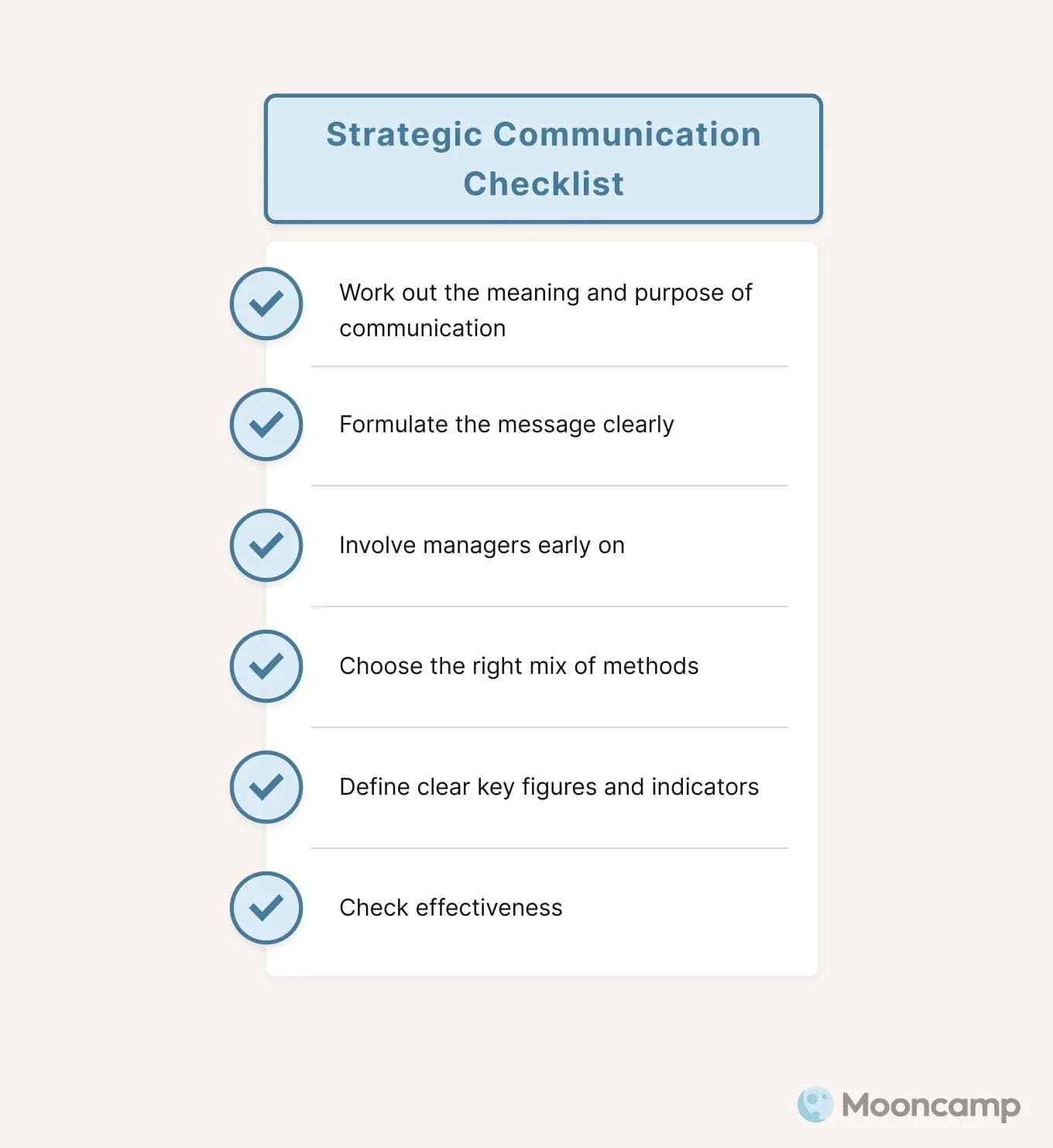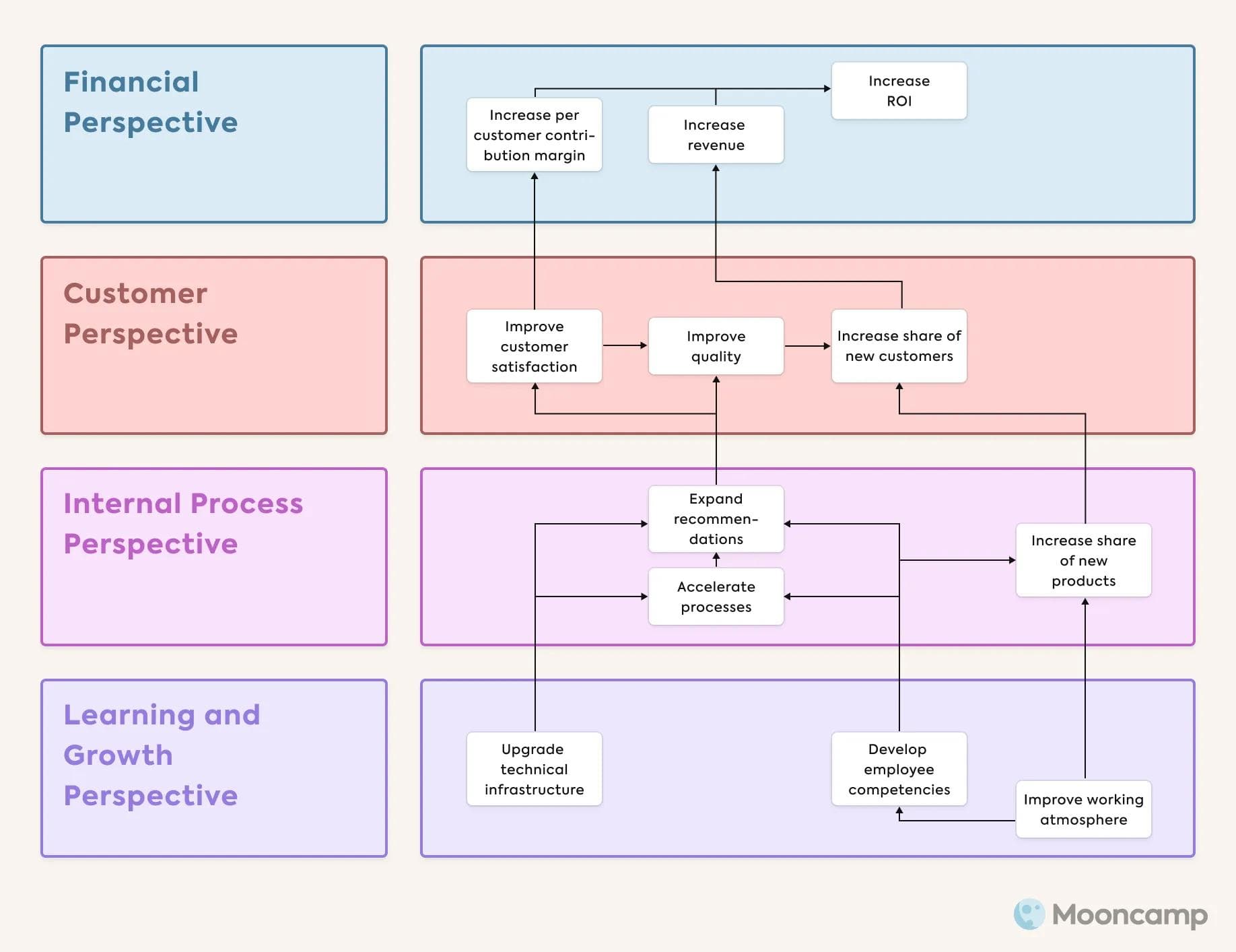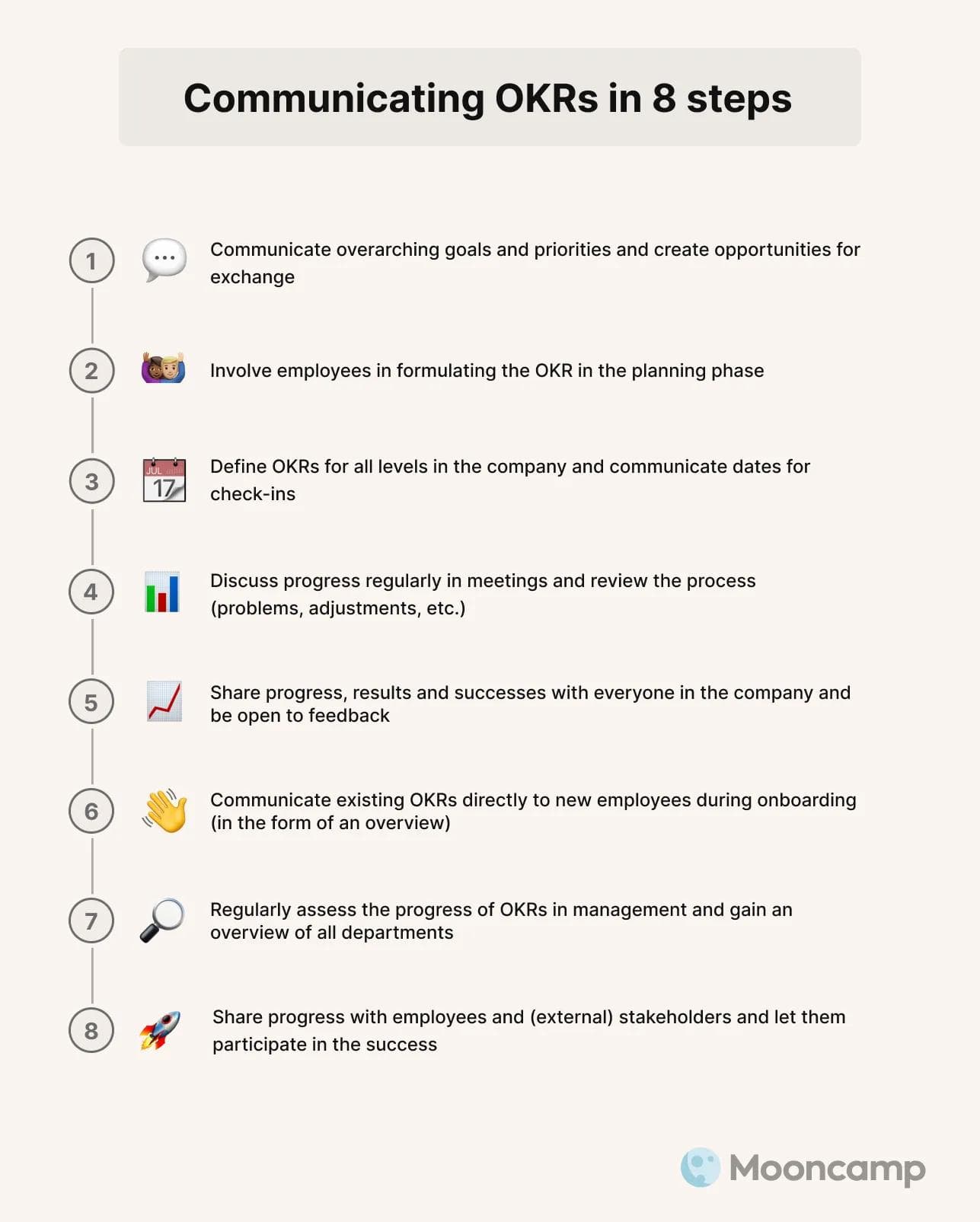Strategic communication: How to communicate strategies effectively

Many corporate strategies fail because they are not present enough in everyday working life. They are forgotten because they are simply not talked about enough. A focused strategy communication ensures that the corporate strategy receives enough attention and is internalized by all employees.
In this article, we have summarized what exactly strategy communication means, what you should pay attention to and which methods and frameworks can be helpful.
What you can expect:
- What is strategic communication?
- Why is strategic communication important?
- What is important for successful strategic communication?
- Which methods can be used to communicate strategies effectively?
- Focus: OKRs as a communication tool
- Conclusion: Clear goals and messages are the key
What is strategy communication?
Strategic communication refers to the uniform communication of corporate strategy to employees. However, it should not be confused with the communication strategy, i.e. the holistic framework for all corporate communication. Instead, it explains the why of the company's goals and provides a guideline for initiatives and decisions in day-to-day business.
At the heart of strategy communication is the question:
How can we communicate our corporate strategy in such a way that our employees understand it and act accordingly?
Why is strategy communication important?
A lot of effort, time and money usually goes into a corporate strategy. Nevertheless, it is only as good as its implementation - and this in turn is only successful if the strategy is also understood by the employees. To achieve this, it should be communicated sustainably. Sustainable means that the strategy is in the minds of the workforce continuously and over the long term.
Many companies fail in strategy implementation because too little is said about the company's strategy and goals. What the management has worked out does not reach the employees, or only for a short time. Corporate strategies are the talk of the town immediately after the launch. However, without sustainable strategy communication, the attention then usually wanes again quickly.
Sustainable and well thought-out strategy communication counteracts this. It ensures that the strategy always receives a minimum level of attention and awareness. In this way, employees not only know and understand the meaning behind their daily work occasionally, but constantly, and ideally contribute to the company's goals with motivation and autonomy.
What is important for successful strategy communication?
For successful strategy communication across all levels of the company, there are a few basic points to bear in mind:
- Work out the meaning and purpose of communication: Before defining measures, it should be clear who you want to reach with the communication and why, what message is to be conveyed and when and how (e.g. on which channels) the message will be communicated.
- Formulate the message clearly: The right wording is needed to ensure that the communication reaches the employees. The strategy should be as easy to understand as possible. Ideally, it should be broken down into a core message. Abbreviations, technical jargon or complex, convoluted formulations are taboo.
- Involve managers early on: The strategy itself usually comes from the management, i.e. from the highest level. However, the managers of the teams and departments should also be brought on board as early as possible for communication. They must have understood and internalized the strategy in order to successfully communicate it to the workforce. In addition, the formulated message can be tested in this group before it is communicated to everyone.
- Choose the right mix of methods: Depending on the phase of strategy implementation, different methods may be more or less suitable. Accordingly, it is important to select the right ones from the wealth of possibilities. A mix of methods usually makes sense. It is important that the methods and tools are coordinated in each phase and fit in with the corporate culture.
- Define clear key figures and indicators: In order to be able to assess how successful strategy communication is, a uniform basis is required. Companies should set clear key figures right at the start and define what success looks like in relation to the strategy. These then form the basis for evaluations and course corrections and are reviewed and discussed on various occasions.
- Check effectiveness: In addition to strategy implementation, you should also measure whether communication is working. This means that not only are key figures relating to the strategy needed, but companies should also regularly analyze whether the communication measures are reaching the workforce.

Which methods can be used to communicate strategies effectively?
Various tools and methods have proven effective for strategy communication, which we will now examine in more detail. These include visualizations, workshops and events. In addition, strategic frameworks such as OKR offer both orientation in setting objectives and an effective communication tool.
💡 As a reminder: OKR (short for "Objectives and Key Results") is an agile framework for the formulation and implementation of strategic goals in companies, which consists of three core elements:
- Objectives: What do I want to achieve?
- Key Results: How do I know that the goal has been achieved?
- Initiatives: How do I achieve the objective?
As a rule, 2 to 4 Objectives are formulated per team and 2 to 4 results-oriented Key Results per Objective. The output is mapped in initiatives (= concrete activities). More basic knowledge can be found in our OKR guide.
Visualization
Visualizing complex topics such as corporate strategy can be a great help for employees. A strategy map, for example, which is normally created as part of the Balanced Scorecard (BSC), has proven useful for this. This strategy map summarizes the strategic cornerstones of the company simply and clearly.

All strategies and goals are named clearly in the strategy map, presented in an understandable way and always present. It becomes apparent what is really important. The strategy map can also serve as a reference point for strategy communication. Employees have an additional visual anchor and discussions about the strategy become easier.
Workshops
Workshops are a good way of breaking down the overarching strategy to the various levels of the organization - first at department level and then at team level.
The management first discusses the strategy in a workshop with middle management. The managers then pass the results on to their teams and work out in further workshops,
- what the team should achieve,
- how the strategy can be implemented in day-to-day work and
- which key figures are used to measure whether the strategy implementation is successful.
In this way, all relevant stakeholders are involved at an early stage. Opportunities and challenges become visible. After the workshops, all departments and teams know how they can implement the corporate strategy for their area.
Events
Management can use special events such as company meetings, seminars and training courses to present and explain the strategic direction in general. The aim is for employees to understand why and to what extent the corporate strategy is important for everyone.
The strategy map already mentioned can provide visual support here.
Information material
Best practice in strategy communication is also comprehensive information material that can be used by managers and employees in their day-to-day work - for example as a template for discussions or as a reference work. This includes, among other things:
- Presentations for workshops, training courses and coaching sessions
- Flyers and brochures that clearly summarize the key aspects of the strategy
- Handbooks and guidelines for managers (e.g. for strategy and staff meetings)
- Texts for internal and external communication (e.g. intranet, newsletters, press releases)
Focus: OKRs as a communication tool
OKRs as a strategic framework enable particularly effective and holistic strategy communication. The method helps to translate the corporate strategy into measurable goals and align all employees with these goals. At the same time, it is also a communication tool that contains many of the aforementioned tools at its core and links them together in a meaningful way.
The advantage: strategy implementation, goal management and communication are practically handled automatically from a single source with OKRs. The method provides a clear framework for this. Teams and employees are continuously confronted with the strategy as part of the fixed events within an OKR cycle (usually a quarter). For example, in OKR check-ins, during OKR planning or in the OKR workshop. Supplemented by other measures such as strategy mapping, training or employee appraisals, OKRs can ensure more sustainable communication.
In general, the corporate strategy forms the basis for the Objectives and Key Results of the individual teams per cycle. It therefore also determines which initiatives are worked on daily.
We will now take a closer look at the specific steps required to successfully communicate a strategy with OKRs.
Communicating strategy with OKRs in 8 steps
The purpose of communicating strategy with OKRs is to ensure that all employees understand the Objectives and know what outcome is expected of them. This means they also understand the corporate strategy almost automatically - provided it has been correctly translated into meaningful OKRs beforehand.
💡 Tip: We have summarized what is important when drafting OKRs in the article "How to write great OKRs" - including formulas and specific examples for inspiration.
A holistic communication strategy can be created around OKRs in eight steps, which accompanies the entire process and aligns all employees with the common vision and the overarching strategy:

How OKR software supports strategy communication
OKR software such as Mooncamp can support strategy communication by visualizing all goals, structures and progress related to the corporate strategy centrally in one place and bundling communication. Integrated check-ins also ensure that everyone keeps an eye on their OKRs and regularly exchanges information.
Once the OKRs have been formulated, Mooncamp also helps with visualization. The Goal Tree is particularly useful here. In the interactive view, the strategic pillars and hierarchy levels of the company can be shown at a glance. This makes it easier for teams and departments to coordinate and the overview can serve as visual support for strategy communication.
Individually configurable dashboards also make it possible to centrally display all key figures and progress as well as the company's vision, mission and strategy.
💡 Tip: You can find out how an ideal OKR dashboard should be structured on our blog.
In order to integrate the OKRs even better into daily communication, Mooncamp also makes it easy to link tools you already use - such as MS Teams and Slack.
Conclusion: Clear goals and messages are the key
Overall, effective strategy communication is crucial for the success of any corporate strategy. It requires clear messages that are understood by everyone. In addition, companies should make sure to involve managers at an early stage and choose suitable communication methods.
The OKR framework offers an effective way of translating corporate strategy into transparent goals and supporting communication.
